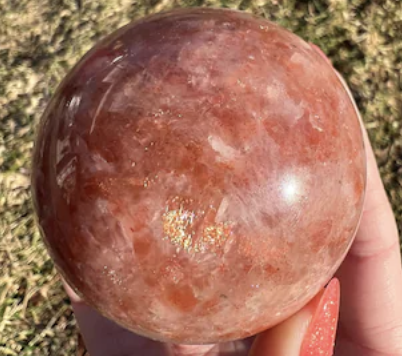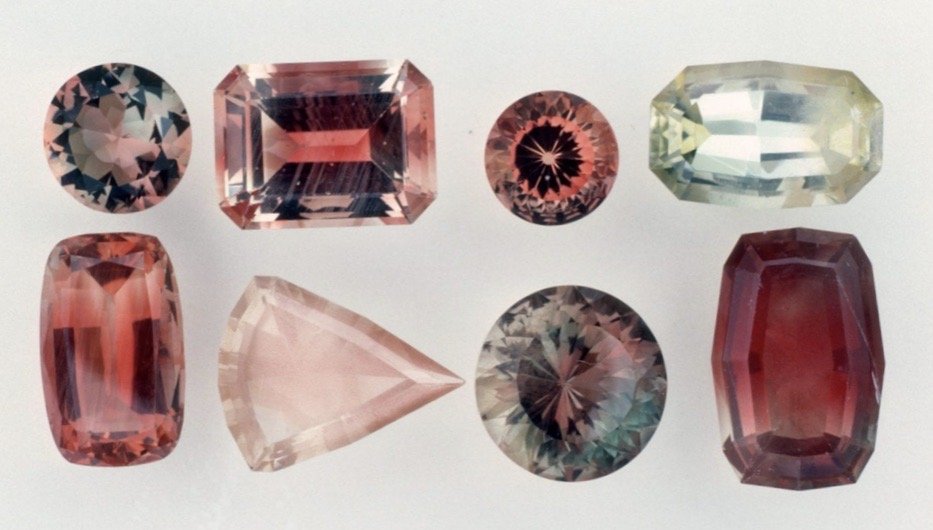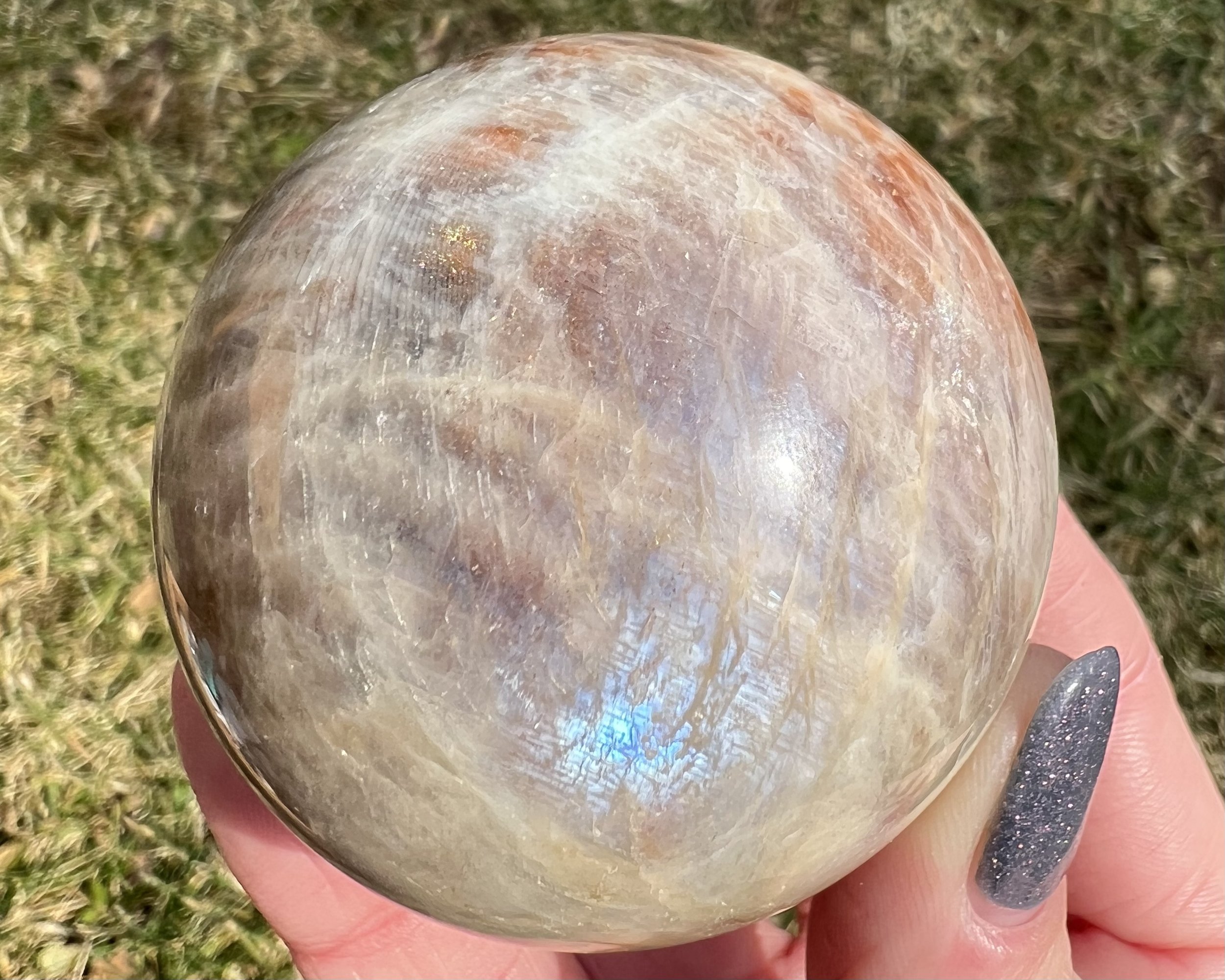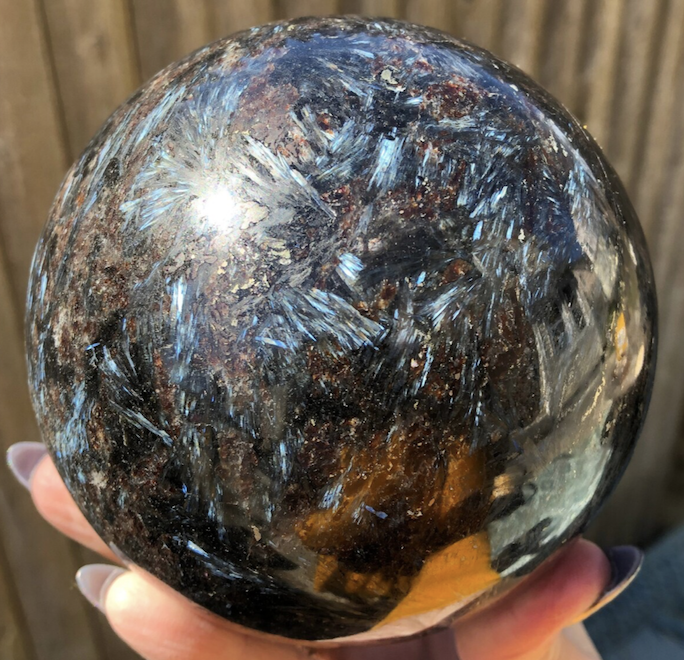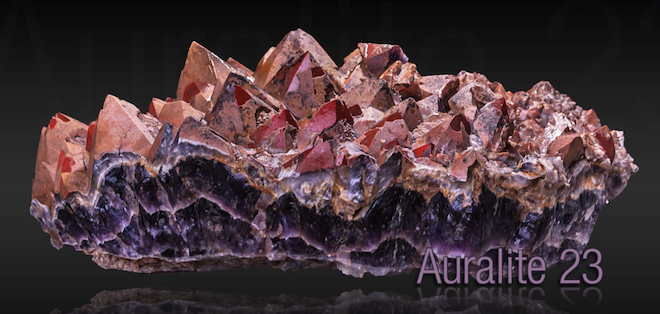
Sunstone and Sunstone and Sunstone
If you look up Sunstone in a google search, you will see many stones that vary wildly in appearance. That is because not all Sunstones are quite the same stone. There are three main types of Sunstones. One is usually mostly orange and more opaque and often has sparkly stuff in it. Another has more sparkles, more rainbows and less orange. The last is more transparent to translucent and may even change colors. They are all feldspars, and have inclusions that cause Aventurescence (also known as schiller) which is "sparkly, metallic-looking luster caused by flat, reflective inclusions" according to GIA. Their mineralogical name is Aventurine Feldspar. Beyond that, these stones have lots of differences.
The Sunstone most commonly seen by the average crystal enthusiast is probably the bright sparkly varieties of the Oligoclase and Orthoclase Feldspar groups. One Oligoclase Feldspar type of Sunstone you've probably seen is from India, cut and polished into spheres and hearts and palm stones. They have bright orange color with shiny Hematite platelets in a variety of colors that give it the trade name "Confetti Sunstone." There are similar varieties of this Sunstone from around the world including Tanzania and Canada.
In Australia, there is a type of Orthoclase Sunstone with long shiny plates of Hematite and Magnetite with rainbow iridescence that can intersect, lovingly called "Rainbow Lattice Sunstone." In these Sunstones the inclusions are hosted in a more translucent or even transparent Orthoclase that shows off the beautiful inclusions in them. In the bottom of this image is another example of an Orthoclase Sunstone- this one from Russia, where the plates are short and hexagonal but also very colorful.
The third type of Sunstone is most famously called Oregon Sunstone. It is the official state gemstone of Oregon. It is technically a type of Labradorite which has Copper inclusions (rather than Hematite ones) that cause its aventurescence. The first recorded occurrence of these stones was by Native Americans who used them in trade and sometimes buried them with their dead. Some Oregon Sunstones have pleochroism, or change colors at different angles. They occur in a range of colors including orange, red, yellow, green and blue.
These Sunstones are the only kind that are faceted often. In the late 1800s Tiffany & Co owned the first commercial mine for Oregon Sunstones which they marketed as "Plush Diamonds" but it didn't catch on as well as they'd hoped and at some point later on they sold the claims. Sunstones are not as popular as other stones in jewelry, but their natural beauty tends to capture the hearts of those who see them up close and in person.
There are mentions of a "sunstone" used by Vikings to navigate the seas in cloudy weather before the invention of the magnetic compass. This "sunstone" however was not Sunstone. We don't know for sure what stone they were using, but a shipwreck from the English Channel that sank in the 1500s had a crystal among its navigation tools, a piece of Optical Calcite- also called Iceland Spar- which is known for its diffraction of light. Many believe that it was pleochroic Iolite, which changes color depending on the angle of light as shown here. Both could be used to determine the position of the sun.
I hope you enjoyed my explanation of Sunstones! You can find several kinds of Sunstones including Rainbow Confetti Sunstones and even Moonstone & Sunstone together, in my Etsy shop. Thanks for reading! -Shawna
Arfvedsonite or Astrophyllite? Neither!
I’ve seen this same stone popping up at trade shows and supplier warehouses for years now, with several different names. Many suppliers call it “Fireworks Stone,” I see lots of it online sold as “Astrophyllite” or “Arfvedsonite.” I’ve seen lots of metaphysical sites comparing the two and proclaiming them to be one or the other. I have spent a long time trying to figure it out and in the past have settled for calling it Arfvedsonite just because I have to call it something. But there are many inconsistencies with those labels when it comes to the stone in question.
First the easiest one - “Fireworks Stone” is not a name of any mineral accepted by any reputable mineral or gem organization. It doesn’t mean anything and doesn’t tell us anything about what it actually is or the minerals in it. We call this a marketing or trade name - someone made it up to sell more rocks because it sounded cool or they didn’t actually know what kind of stone it was- or both.
Next, Astrophyllite. It forms gold, iridescent sprays much like the ones seen in the material in question. However, according to Mindat its color is “bronze-yellow, golden yellow, brown to reddish brown.” The stones that I have seen of the mystery material often have more blue than gold and yellow. Sometimes they are more gold too, but it cannot be Astrophyllite when so much of this material is so very blue. Astrophyllite also occurs more in radial “sun” shapes which often form full circles. Our mystery stone forms more often in “brush” shapes like a paintbrush pressed against a surface.
The third contender is Arfvedsonite. This is what I most commonly see this stone called online. If you post it in a mineral ID group, there will always be someone (never one of the geologists or mineralogists) who jumps to argue that it is Arfvedsonite. Mindat says the color of Arfvedsonite is “bluish-black to black” and in their gallery of 225 photos of Arfvedsonite specimens, all of them look closer to a Black Tourmaline than the material we are trying to identify. Every photo from a reputable source appears much like this photo - very dark or black crystals. Nothing iridescent gold or blue at all.
Finally after many hours spread over several years down this rabbit hole I believe I have found the answer. The name of the mineral in question is Anthophyllite. Anthophyllite is a fibrous amphibole mineral. It is also iridescent but can have gold, yellow, green, blue, and brown - so the iridescence of Anthophyllite fits much better than either of the other minerals it is often called.
On Mindat, there is a photo in the gallery for Anthophyllite that very much resembles the mystery material. It is labeled “Anthophyllite, Garnet, Cordierite.” The piece that I currently have does appear to have a lot of sparkly Almandine Garnet, which makes it a much more believable identification than other minerals. I have often seen the red part of this material called Eudialyte, but none of the aforementioned minerals appear to occur much in association with Eudialyte. My guess is that someone assumed it to be Eudialyte because that is a red mineral associated with Astrophyllite. Anthophyllite, on the other hand has both Garnet and Cordierite listed under common associates.
Another mineral listed under Anthophyllite’s common associates is Gedrite. This is interesting because Gedrite looks pretty similar to Anthophyllite, occurring in fibrous sprays, but is mostly black or dark green. The photo on the left here is Gedrite with Garnet. In the material I have now, shown on the right, there is a lot of shiny black sprays that are around the golden ones, and Anthophyllite and Gedrite do indeed occur together. Random fun fact- Gedrite and Anthophyllite alone together have a trade name you’ve probably heard before - Nuummite!
I found an article on Epigem that talks about this stone pictured, found in Sweden and described as an Anthophyllite schist “with reddish brown garnet, granular epidote and colorless cordierite.” This makes so much sense because so many of the pieces of this material I’ve had also had bits of green in them, and the one I’m looking at now does have some areas of clear stone that appears to sparkle similar to other cordierites I have had. In comparison, Cordierite does not often occur with Arfvedsonite, which mostly forms on Feldspars. It is also not listed as an associated mineral of Astrophyllite. So again, it seems that Anthophyllite is the most likely identification of these no-longer mysterious iridescent blue and gold sprays.
Crystal Names™ to Be Mindful Of
Super Seven. It sounds simple enough. It means that it has a combination of 7 minerals- Amethyst, Smoky Quartz, Quartz, Cacoxenite, Lepidocrocite, Rutile, and Goethite. It is also called Melody Stone™. Let’s start with the easiest problem with this claim. Amethyst, Smoky Quartz and clear Quartz are all variations of one mineral - Quartz. So are Citrine and Rose Quartz. They are not separate minerals.
There are also two inclusions in this list that pose quite the conundrum- both Cacoxenite and Lepidocrocite have been disproven to occur in Quartz by laboratory analysis. Cacoxenite in Quartz is actually Goethite. Often lustrous, golden colored and occurring in fan-like sprays.
Our next imposter is Lepidocrocite, which in any Quartz is actually Hematite. Hematite occurs in many forms, in many different colors, in many different locations all over the world, and looks a lot of different ways. Another popular one that is often mislabeled is the “Strawberry Quartz” of Orange River and Namibia, especially the Brandberg area. Yet again these are Quartz and Amethyst with Hematite.
That brings 3 of our minerals down to one, and the other 4 down to 3, though one is changed. We have Quartz, Hematite, Goethite and Rutile. Maybe they should re-trademark it Super Four. Melody holds the trademark for “Super Seven™,” a made up marketing term to make more money on anything they can. "Auralite 23™” is the Canadian version, with an even more ridiculous list of supposed inclusions.
Robert Simmons is another person who loves to trademark any stone he can get enough of to market under a new name and charge ridiculous prices for them. This not only makes crystals cost more for everyone, but confuses many on what they actually are. Azeztulite™ (low grade Quartz from anywhere convenient to Robert Simmons), Healerite™ (lighter green Serpentine), Blue Moon Quartz™ (Dumortierite Quartz), Agnatite™ (Red Hematoid Quartz from Madagascar), Anazez™ (Chevron Amethyst from Africa), Transmutite™ (Petrified Wood from Nevada) and Cinnazez™ (Cinnabar and Zinc in Quartz) are a few of the stones they have re-named with trademarks.
Another problem that this causes is that online sellers like myself often need to included these fake names in our titles and listings because we need to use the names that people are familiar with and using to search for them, which further perpetuates the use of these names. There are many of them, not all are trademarked. Many are just made up, bad translations, or mislabeled names that have become more popular than the stone’s true name.
In the end, you can believe that Azeztulite is a special Quartz blessed by the Azez Angelic entities but it seems pretty sus that it (and many of his trademarked stones) happen to come from the places that Robert Simmons has lived. You can pay hundreds of dollars for a small piece of low grade, cheap stone if you want to, I won’t stop you. But information is power, and being informed about the stones you buy is important for all buyers of crystals whether you own a handful or a houseful. I hope you find this information helpful.
Thank you,
Shawna
Kouva Dream Catchers and Crystals
New Moon Ritual: Setting Intentions
The New Moon occurs when the Sun and the Moon are on opposite sides of the Earth, and none of the light from the Sun is reflecting off of the Moon. The New Moon is a moment of darkness, a prime time for reflection, release and setting new intentions.
There are many rituals out there for New Moons, many of them long, elaborate and requiring a lot of tools or ingredients. Maybe you don’t have the time or the energy for all that. Maybe you don’t consider yourself a ‘witch,’ per se, or maybe you don’t have a large dedicated sacred space. Maybe you don’t have time to spend an hour in a fancy herbal salt bath surrounded by black candles. I’ve come up with a pretty easy, simple New Moon ritual that anyone can do with a few simple things that most of you will already have in the house. It doesn’t take up your whole night, and its still powerful af.
Step 1: Grab your journal or some paper and a pen, and write down everything you need to get out. Write about things you’ve had on your mind, things that have been bothering you, and just vent. Release all your worries and grievances into the paper, without thinking too much and without judgement. Just write it down and feel the tension and negativity leaving your body.
Then, write at least two things you are grateful for. They could be things that happened today, things that made you laugh, or things that you are grateful for everyday like your kids or your car. They can be as small or big as you want.
Finish off by writing about the future. What are things that you want to happen in the next four weeks or beyond? Just let your mind wander and write down wherever it goes. Don’t take more than five minutes for this part, as it can spiral out of control pretty easily.
Step 2: Cleanse your space. Whether you’re at an altar, sitting on your bed, or hiding in the bathroom, you’ll want to cleanse your self, your space and your tools. You can use sage, Palo Santo, juniper, rosemary, and other plants to cleanse with smoke. If you can’t use smoke, there are smudging sprays available too. (This one is my fave.) You can also cleanse with sound, using a singing bowl, gong or bell.
Step 3: Light a candle. It can be any candle you’ve already got, or a special one that you only use for New Moons, or even a fancy specific ritual candle made just for you. It is up to you to choose the type of candle you want to use. Smaller ones tend to be better because you’ll want to let it burn out on its own.
Optional: Charge your candle! After it has been cleansed, hold the candle, feel gratitude and love, visualize what you want, and ask for it from the Universe. Light the candle and place on a heat-safe surface.
Step 4: Crystals. You should gather the crystals you’d like to use before you begin the ritual so that they are part of your cleansing. You might also cleanse all of your crystals as part of your ritual, and then choose them when you are ready. When it comes to choosing which crystals you will use, you can pick whichever ones you feel most drawn to, or ones that are most related to your intentions, or use these New Moon faves: (click on any name to shop that type of stone)
Moonstone: For tapping into lunar energies, new beginnings, inner strength, intuition
Labradorite: For transformation, strength, easing change, hidden magic, reinvention, self love
Clear Quartz: For magnifying, energy cleansing, balance, manifestation
Black Tourmaline: For grounding, protection, blocking and removing negative energy
Indigo Gabbro: For connecting to New Moon energy, clairvoyance, seeing your inner darkness, balance between light and dark
Step 5: Setting intentions. Write down your intentions on a fresh piece of paper that you will keep and refer to for the next four weeks. Write your intentions as if they are already happening now. Write them with gratitude. Avoid negatives- what you focus on becomes your reality. (For example, if you want to become free from debt, focus on wealth and financial freedom - not the debt!)
After you write each intention, visualize it as if it is already true- and most importantly- FEEL those feelings that this reality gives you. If you’re manifesting money, imagine the money is in your hands- see it, feel it, visualize yourself spending it - giving it purpose - and FEEL the feelings of gratitude, of having financial independence, and whatever feelings that makes you feel. To HAVE that now. Go through this for each intention. Feeling them as if they are already here is the most important part.
Step 6: (Optional) Meditate, do a tarot reading, or both. You could do a simple five minute meditation to clear your mind and listen for your intuition. You could do a simple three card spread. One example could be 1. Where you are now 2. What to release 3. What action to take.
Step 7: Make a list of 3-5 steps you can take this moon cycle toward making your intentions a reality. They should be actionable steps, they can be as small as researching or scheduling an appointment or as big as hiring a coach or applying for that position you want. But they need to be specific actions that you can take. At least one should be something you can do in the next few days.
Step 8: (post ritual) Put your intentions somewhere you can see them every day. As often as you can find a few spare minutes, read each one aloud, using visualization and feeling those feelings, to make them true. Cross off your steps as you complete them, and add another step for each completed one. This will keep you from losing sight of your goals.
Andara Crystals: Trash or Treasure?
Maybe you’ve heard of Andara Crystals before. They’ve become popular in the metaphysical realm of crystals the last few years. According to one popular seller they are natural glass which “come from one of the Earth’s high-energy vortex sites in the High Sierra Nevadas of northern California, Lady Nellies Land.” There are a vast range of claims about Andara glass and the amazing things they can do.
One is that it contains something called “entherium,” containing 70 different minerals. This is complete nonsense. Entherium is completely made up and these pieces of glass do not have 70 minerals in them.
They also claim to be Monatomic - which means of one atom. Doesn’t make any sense in this s scenario.
I have read claims that Andara glass can aid in time and space travel, raise our vibrations, detox negativity, heal you, cleanse the chakras and it seems that there’s nothing these people WON’T say it can do! And they have price tags to match, with small pieces going for hundreds or thousands of dollars.
Sorry folks but Andara glass, regardless of what the seller says, is slag glass. It is the garbage found at an old abandoned dumping ground of a glass factory. Several “healers” buy the slag glass and distribute it to each other, making up names and creating “certifications” for each other. It’s ALL a scam. People are paying thousands of dollars for beautiful, lovely garbage. And hey- they are pretty! But you can buy the same exact thing for almost nothing from honest slag glass sellers.
There is a thread about the Andara scam on Mindat (one of the most reputable sites and forums for those who are truly interested in learning about minerals - frequented by many true experts of mineralogy and geology!) and one entry is a woman that says she is the only one who has a certain color of the glass, called “King Solomon,” and found out one of her buyers was reselling her glass as Andara glass. The woman expressed that she was very angry that her material was being used to scam others. In the thread, they even name some of the people responsible for the whole scam.
It just so happens that ‘new’ color variations of Andara glass happen to be ‘found’ at the same times that glass companies start dumping those same new colors. Huh. I can see how one could easily believe in the story of Andara glass, because Obsidian exists, but with a bit of research the evidence stacks up ridiculously tall against it being anything but an elaborate scam. I hope that this can save someone from wasting a lot of their hard earned money on a piece of slag glass they could get elsewhere for a few bucks.
What other fakes, frauds or scams have you heard of??
Please comment below!
-Shawna


